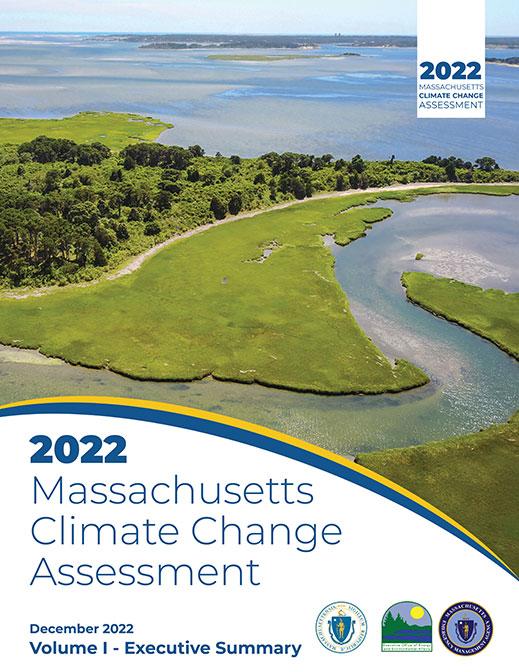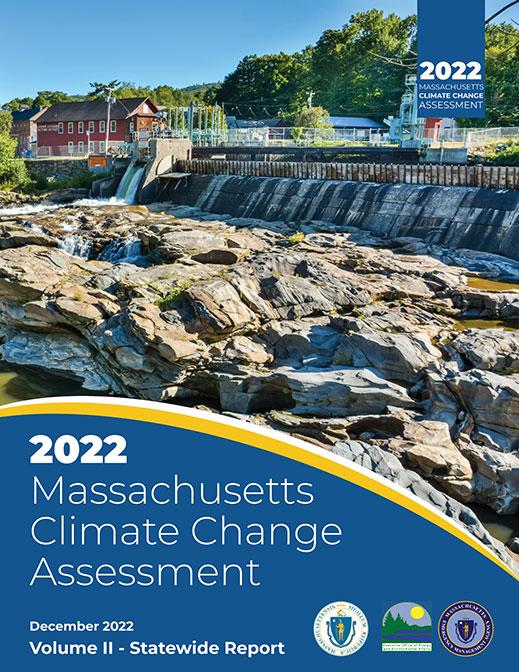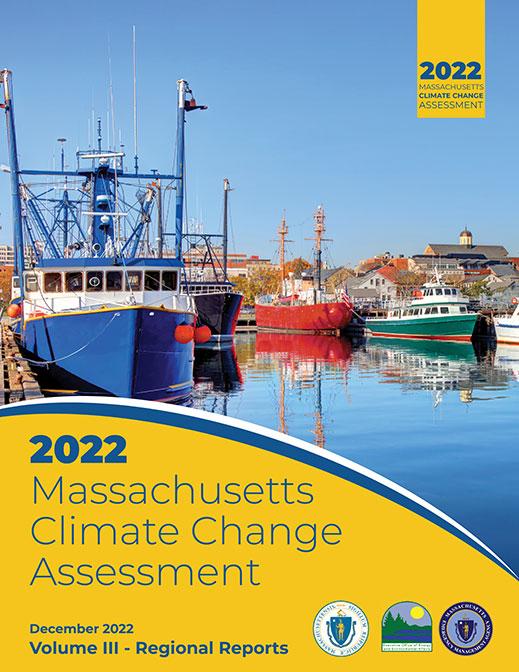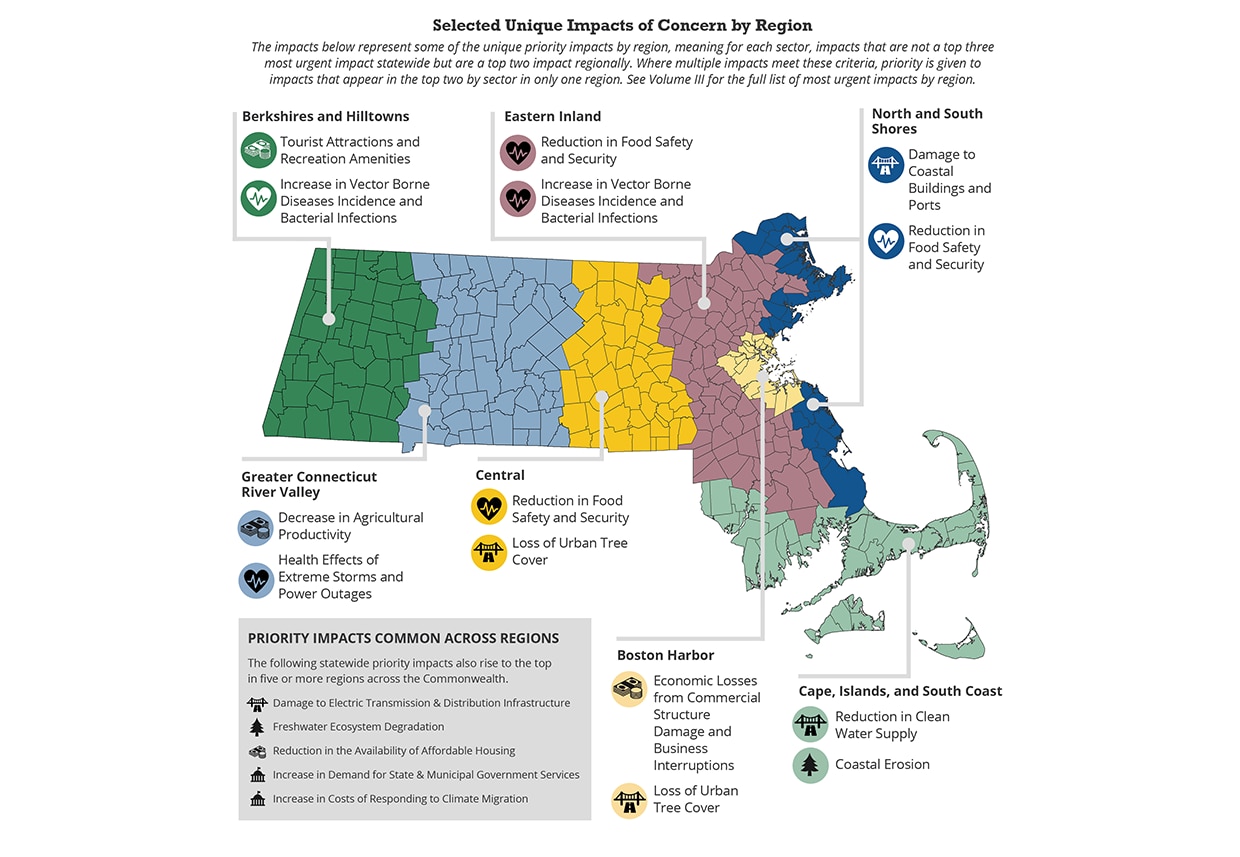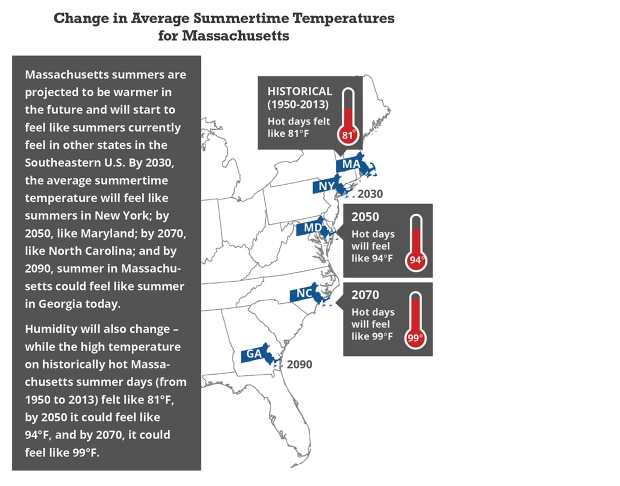Read the Report
- Executive Summary (Volume I):
- Full Statewide Report (Volume II)
- Regional Summaries (Volume III)
- Regional reports
Project Overview
The Massachusetts Climate Change Assessment (Climate Assessment) evaluates the impacts of climate change to the Commonwealth, including human health and safety, natural resources, and public and private assets. The Climate Assessment served to directly inform the 2023 update to the State Hazard Mitigation and Climate Adaptation Plan (SHMCAP), which was released in fall 2023.
Aligned with the SHMCAP, the Climate Assessment evaluates 37 climate impacts across five sectors and seven regions of the Commonwealth:
- Human: Impacts to people’s health, welfare, and safety
- Infrastructure: Impacts to buildings and transportation systems, and how we get our electricity and water
- Natural Environment: Impacts to ecosystems and natural resources, and how plants and animals can thrive here
- Governance: Impacts to state and local government owned facilities, government finances, and demand on government services
- Economy: Impacts to people’s ability to work and make a living, due to damages to infrastructure, our natural environment, or people’s health, and people’s ability to find housing that is affordable.
The primary objective of the Climate Assessment is to identify urgent climate risk statewide, as well as by each region and sector. Risk rankings were developed through discussions with the project working group and stakeholders, and considered:
- How big of a climate effect will this have? Quantitative and qualitative indicators of the scale of potential impact, analyzed under the defined future climate scenario.
- Will populations living in environmental justice areas be disproportionately affected? Demographic analysis of the distribution of impact across populations, particularly the Commonwealth’s identified environmental justice and socially vulnerable groups.
- Are we currently doing enough to adapt to this impact? Assessment of current and planned adaptation plans and actions, and the potential benefits of additional adaptation action.
Top Climate Impacts Statewide by Sector
The impacts below represent the most urgent impacts per sector statewide identified through the urgency ranking process. The Statewide Report (Volume II) of this report provides detailed results for the top three impacts per sector (four in the case of Natural Environment due to tied scores); details on the remaining impacts can be found in Appendix A.
Human
Health and Cognitive Effects from Extreme Heat, including premature death and learning loss.
Health Effects from Degraded Air Quality, including childhood asthma cases and premature death due to the climate impact on particulate matter and ozone air quality.
Emergency Service Response Delays and Evacuation Disruptions from extreme storms, leading to injuries, loss of life, and requiring health, safety, and traffic first responders.
Learn more about climate impacts in the Human sector.
Infrastructure
Damage to Inland Buildings from heavy rainfall and overwhelmed drainage systems.
Damage to Electric Transmission and Utility Distribution Infrastructure associated with heat stress and extreme events.
Damage to Rails and Loss of Rail/Transit Service, including flooding and track buckling during high heat events.
Learn more about climate impacts in the Infrastructure Sector.
Natural Environment
Freshwater Ecosystem Degradation due to warming waters, drought, and increased runoff.
Marine Ecosystem Degradation because of warming, particularly in the Gulf of Maine, and ocean acidification.
Coastal Wetland Degradation from sea level rise and storm surge.
Forest Health Degradation from warming temperatures, changing precipitation, increasing wildfire frequency, and increasing pest occurrence.
Learn more about climate impacts in the Natural Environment Sector.
Governance
Reduction in State and Municipal Revenues, including a reduced property tax base due to coastal and inland flood risk.
Increase in Costs of Responding to Climate Migration, including planning for abrupt changes in local populations.
Increase in Demand for State and Municipal Government Services, including emergency response, food assistance, and state-sponsored health care.
Learn more about climate impacts in the Governance Sector.
Economy
Reduced Ability to Work, particularly for outdoor workers during extreme heat, as well as commute delays due to damaged infrastructure.
Decrease in Marine Fisheries and Aquaculture Productivity from changing ocean temperatures and acidification, which leads to decreased catch and revenues and impacts on related industries.
Reduction in the Availability of Affordably Priced Housing from direct damage (e.g., flooding) and the scarcity caused by increased demand.
Top Climate Impacts by Region
Priority impacts by region may differ from statewide priorities based on the specific hazards, natural and built environments, and demographics of the region. More details on regional results can be found in the Regional Report (Volume III) of this Climate Assessment.
Learn more about the seven regions covered in the Climate Assessment: Berkshires and Hilltowns | Greater Connecticut River Valley | Central | Eastern Inland | North and South Shores | Boston Harbor | Cape, Islands, and South Coast
Climate Change in Massachusetts
The best climate science for Massachusetts continues to stress three findings: temperatures have gone up over the years and will continue to increase; there could be both fewer rainy days and more intense rainstorms; and sea levels will rise and combine with more powerful coastal storms.
The latest climate science for Massachusetts was reviewed by statewide experts and applied to estimate impacts to human populations, and natural, and infrastructure assets. Key climate hazards include warmer temperatures and more heat waves that are connected to human health, droughts, agriculture yields, and a need for infrastructure repairs. Other projected changes include more frequent seasonal droughts affecting water supply and agriculture; more intense days of high rainfall, increasing flooding; more intense and frequent coastal storms that cause power outages, injuries and deaths, and damaged infrastructure; and gradual sea level rise, which changes ecosystems and the coastal built environment.
Public Engagement
The project team identified priority climate impacts through conversations with state agency staff, local and federal government partners, non-profit and community group representatives, and public stakeholders.
The Project Working Group included state, local, and federal agency representatives as well as other experts from non-profits and community organizations. Project Working Group members assisted in the development of the list of 37 impacts, provided data sources to evaluate the impacts, and reviewed the urgency rankings and underlying analyses. In addition, an expert Climate Science Panel, consisting of Massachusetts academics with deep climate science and impact assessment backgrounds, provided critical input to the use of climate projection data used in the Climate Assessment.
Public stakeholder engagement occurred in three waves over the course of the Climate Assessment. In each wave, stakeholders were asked to answer a key question to inform the Assessment. A team of community liaisons from across the state encouraged participation in the public conversations.
Wave 1: Climate Impact List Development
In the first wave of engagement, ten community leaders were recruited from different regions across the Commonwealth to serve as Community Liaisons (CLs). CLs provided feedback to the project team on planned stakeholder engagement activities and conducted outreach among their networks
Four virtual public meetings were held on March 1, 3, 8 and 9, 2022, which engaged 245 stakeholders across the Commonwealth. Simultaneous interpretation was available in Spanish, Portuguese, Haitian Creole, Mandarin, Vietnamese, and Cape Verdean Creole. You can watch a recording of the presentation given at all four workshops:
Wave 2: Climate Impact Urgency Ranking
Four virtual workshops were held in June 2022, which engaged 121 stakeholders across the Commonwealth. These meetings provided an overview of climate change impacts and gathered community input on prioritizing adaptation actions to address these impacts. Simultaneous interpretation was made available upon request. You can view a recording of the presentation and the presentation slides below:
- MA Climate Change Assessment Public Workshop #2 – June 2022 - YouTube
- MA Climate Change Assessment Public Workshop #2 Presentation
A survey was conducted in the top ten languages spoken across the Commonwealth. A total of 443 stakeholder responses were received. In addition to collecting ongoing feedback from community liaisons, interviews with stakeholders were conducted to capture input from groups that were unable to participate in the first wave.
Wave 3: Initial Assessment Findings and Consensus Building
A series of stakeholder interviews and focus groups were conducted to gather feedback on the initial assessment findings. A draft report was released for public comment.
Quick links
- ResilientMass Homepage
- ResilientMass Metrics
- ResilientMass Site Map
- Massachusetts Climate Change Assessment – Human Sector
- Massachusetts Climate Change Assessment – Infrastructure Sector
- Massachusetts Climate Change Assessment – Natural Environment Sector
- Massachusetts Climate Change Assessment – Governance Sector
- Massachusetts Climate Change Assessment – Economy Sector
- Massachusetts Climate Change Assessment – Berkshires and Hilltowns Region
- Massachusetts Climate Change Assessment – Greater Connecticut River Valley Region
- Massachusetts Climate Change Assessment – Central Region
- Massachusetts Climate Change Assessment – Eastern Inland Region
- Massachusetts Climate Change Assessment – Boston Harbor Region
- Massachusetts Climate Change Assessment – North and South Shores Region
- Massachusetts Climate Change Assessment – Cape, Islands, and South Coast Region
- 2023 ResilientMass Plan
- 2023 ResilientMass Action Tracker
